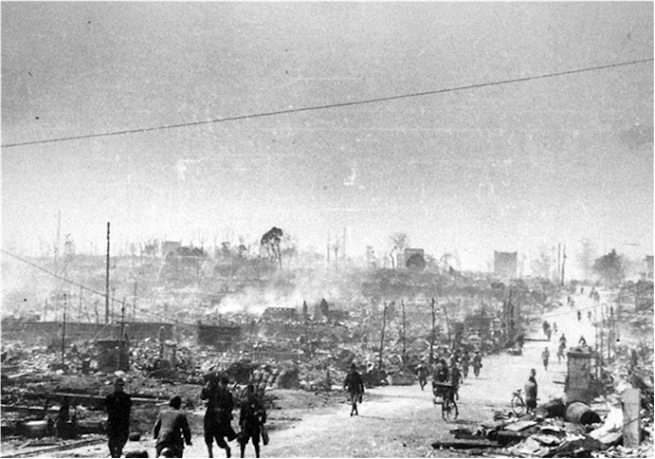Asakawa Kan'ichi: Rescue Scheme Of The Devastated Japan
Fig.
Tokyo shortly after the defeat.
Source:
https://commons.wikimedia.org/wiki/File:Tokyo_kushu_1945-4.jpg
Original title: Tokyo kushu 1945-4
This photograph is in the public domain
Asakawa Kan’ichi (1873 –1948) was a Professor of History at Yale, peace advocate, and a curator at Yale Library. He was born in Japan as the son of a samurai, however, he spent most of his time in America.
Fig. Asakawa Kan’ichi
"Kan'ichi Asakawa Papers (MS 40).
Manuscripts and Archives, Yale University Library."
https://japanesehistory.yale.edu/about
I have previously described Historian Asakawa Kan’ichi in one of my blogs [1]. I also described the August 22, 1945 letter of an American historian Langdon Warner to Asakawa [2] to consider a rescue scheme of the devastated Japan. In his long response to Warner [3] dated February 7, 1946, he wrote
The letter ends with “Moreover” suggesting that he had something more to say.
S. Yabuki [4] comprehends that this long letter should be read not only by Warner but the Japanese people, in general, because it contains detailed rescue scheme of the devastated Japan. It, however, is highly challenging to comprehend for a layman like myself. In [4], Yabuki deciphers another long handwritten memoir of Asakawa which contains many of the contents of the Asakawa letter to Warner and appears easier to comprehend for a layman. In this blog I attempt to extract Asakawa’s rescue scheme deciphered by Yabuki [4]. This endeavor is far from trivial for me. It is my contention that, "If I think I can’t, then I can’t." Here is my elucidation of what he meant:
[4] (translated by the author)In order to consider his rescue scheme, he discusses strengths and weaknesses of the Japanese people in Section 4 of the memoir.
Section 4: Study of National Characteristics of Japanese People
“This is the ultimate purpose of this memoir.
Japan is now in an absolutely unprecedented period of her history such that
many unusual phenomena militate. “
(translation by the author)
GHQ (General Headquarters) [6]
The Supreme Commander for the Allied Powers (SCAP)
was the title held by General Douglas MacArthur during the United States-led
Allied occupation of Japan following World War II. The position was generally
referred to as GHQ. MacArthur announced that he seeks to "restore
security, dignity and self-respect" to the Japanese people.
Fig.
MacArthur.
General
of the Army Douglas MacArthur smoking his corncob pipe, probably at Manila,
Philippine Islands, 2 August 1945.
Date 2 August 1945
Source Naval Historical Center; Direct link.
Photo #: USA C-2413 (Color), photograph from the Army Signal Corps Collection
in the U.S. National Archives.
Author Photographer not credited.
https://commons.wikimedia.org/wiki/File:MacArthur_Manila_(cropped2).jpg
This is in the public domain.
The way this memoir was written indicates that it was
not yet complete. However, shortly after writing this memoir, he passed away in
1948 without completing it. Thus, he didn’t observe an important event:
MacArthur, who dismantled the military and zaibatsu (business conglomerates) while maintaining social order in post-war Japan, was a capable general. However, the outbreak of the Korean War and the establishment of the Chinese Communist Party caused a sudden shift in US occupation policy, leading to MacArthur’s dismissal.
A significant event in history can render even a
capable general powerless. MacArthur was a potential candidate for the
presidential election. Japan’s trajectory after MacArthur is beyond the scope
of this blogpost, however, I would like to see at least one quantitative data
on democracy of Japan as late as possible. The following is one of the many
such indices from [7]. Ther are two reasons that I included these six
countries. One is that I have shown in [5] Real GDP per capita of India, China,
America, Germany and Japan for 1600-2018. Another is the fact that Norway is
often cited as a country whose democracy index is high.
Fig.
Democracy Index 2017
Source:https://ourworldindata.org/grapher/democracy-index-eiu?tab=table
It is by no means the best such index, however, it
would be worth looking at. If one compares this with some of the graphs I
posted in my earlier blog post [5], I wonder if Japan has done a reasonable job
of the Asakawa scheme.
Reference [8] contains much discussion on Asakawa.
[1] https://japanlatebloomer.blogspot.com/2023/10/japan-is-late-bloomer-civilization.html
[2] Warner, L., “Letter to Asakawa” in “Letter
of Dr. Kan’ichi Asakawa”, Waseda University Press, Tokyo, 1990
[3] Asakawa, K., “ Letter to Langdon Warner”,
Yamaoka, M., Masui, Y., Igarashi, T., Yamauchi, H., Sato, Y., “Asakawa
Kan’ichi Shiryo, Letter to Langdon Warner”, Waseda University, Asia-
Pacific Research Institute, Tokyo, 2015, pp. 307-308.
[4] Asakawa, K., “Shinsei Nihon no Tenbo”,
in Yabuki, S., “Haisen, Okinawa and Tenno (Defeat, Okinawa and
Emperor)”, Kadensha, Tokyo, 2014
[5] https://japanlatebloomer.blogspot.com/2023/10/japan-is-late-bloomer-civilization.html
[6] wikipedia site:
https://en.wikipedia.org/wiki/Supreme_Commander_for_the_Allied_Powers
[7] Democracy
Index 2017: https://ourworldindata.org/grapher/democracy-index-eiu?tab=table
[8] Yamauchi, H., “Asakawa Kan’ichi Ron”,
Waseda University Press, Tokyo, 2010


























Comments
Post a Comment